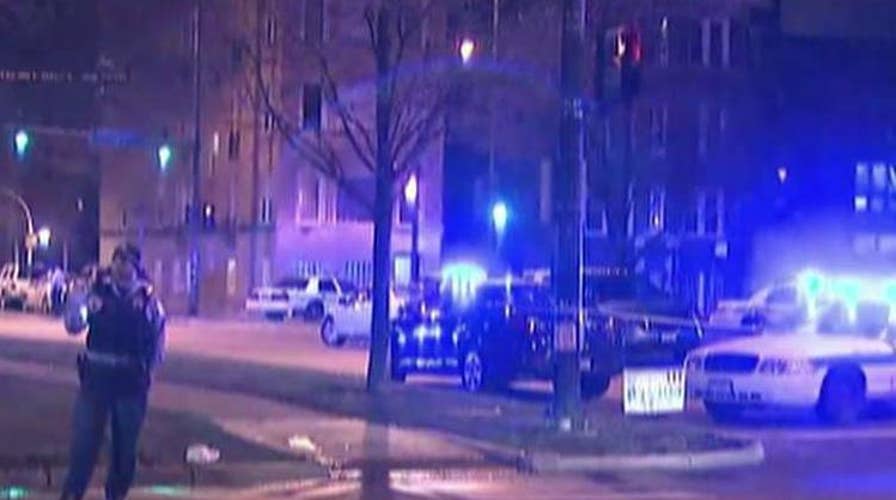Three Chicago cops wounded in overnight shootout
Attacker shot dead, all three officers expected to survive injuries
Lamar Harris had seven felony convictions and 43 arrests when he shot three Chicago police officers. The same week, Samuel Harviley, who had just been paroled after serving less than half of his sentence for armed carjacking, shot yet another of the Windy City’s finest.
Police officials, researchers and many elected leaders all agree that the pair were prime examples of the violent pool of criminals driving the city’s historically high crime rate. Ex-cons well-known to police and with a proven propensity for violence are being let out early from prison or let off lightly by judges, only to wreak havoc on the city, they say.
“We are not incarcerating a bunch of harmless sad sacks who are merely caught with a joint.”
"The fact that a convicted felon and gun offender is yet again out on early release to torment communities is representative of the types of individuals who are overwhelmingly driving the recent spike in violence," then-interim police Superintendent John Escalante said at a news conference last month announcing charges against Harviley.
The cycle of violence has resulted in more than 800 shootings so far this year, including seven shootings and one murder on April 4 alone. Escalante’s successor, former Chicago Police Department Chief of Patrol Eddie Johnson, says the rate of murders and shootings can’t be reversed until the criminal justice system begins to hold offenders accountable.

Mayor Rahm Emanuel, (r.) named Eddie Johnson, (l.) interim superintendent of the Chicago Police Department last month. (Chicago Sun-Times, via AP)
“We have five districts that are driving the crime in the city,” Johnson said in a recent radio interview. “And within those districts, there is a small subset of individuals who are responsible for those crimes. They have multiple arrests for gun offenses and until we start holding these people accountable [the problem will persist].”
According to the CPD’s most recent CompStat figures, 133 people have been murdered in 2016, compared to 77 during the same period in 2015. Shootings are up 91 percent.
Johnson, unlike many of the city’s African-American elected officials, is seeking tougher sentencing laws. Over the coming weeks, he plans to be “asking our legislative partners in the near future to help us” pass new laws that will ensure judges throw the book at violent offenders.
It’s become easy for police to predict who will be on both ends of the explosion in gun violence. Some two-thirds of murder victims are already on the Police Department’s “strategic subject list,” a roster of residents identified as being at risk of being a victim or an offender of gun violence. The list is kept so police can carry out lifestyle intervention efforts.
In one weekend in late March, 76 percent of shooting victims were on the SSL and 95 percent had lengthy criminal histories.
Illinois is one of several states implementing recommendations from prison reform commissions to reduce or even eliminate mandatory minimum sentences. Those groups seek to reduce prison populations by as much as 25 percent.
The movement to slash sentences and free inmates is given momentum by controversial, police-involved shootings that galvanize communities, as well as protests by Black Lives Matter and civil rights groups. But shortening sentences of violent offenders puts both police and law-abiding residents of the inner city at risk, say law enforcement officials.
“Every day our members risk life and limb to defend our constitution and the rights it affords our citizens,” wrote Dominick Stokes, vice president for legislative affairs for the Federal Law Enforcement Officers Association in a December letter to Senate leadership. “Mandatory minimums are a vital tool utilized in dismantling criminal drug trafficking enterprises.”
Stokes’ group is opposed to the Sentencing Reform and Corrections Act of 2015, one of several bills aimed at reducing or eliminating mandatory prison sentences on the Federal level. And researchers say laws that ensure robust prison terms for dangerous people keep everyone safe.
“We are not incarcerating a bunch of harmless sad sacks who are merely caught with a joint,” said Heather Mac Donald, of the Manhattan Institute, a non-partisan research institute. “Prisons today mostly house violent criminals. Prison populations have increased because violent crimes increased.”
Mac Donald acknowledges some validity to arguments against imprisoning non-violent drug offenders, but rejects claims that rising incarceration rates are a consequence of racism.
But others say longer and tougher sentencing laws do little to reduce recidivism.
“There is value in punishment, but you have to think about how to use it effectively and the threat of longer sentences does not have a deterrent value,” said Samuel Bieler, a criminologist with the Urban Institute. “What is needed is a way to transition [prisoners] into the community and the sooner you can do that, the better.”
Chicago Police spokesman Anthony Guglielmi said the department is fighting back, with gun arrests up 43 percent since mid-February and arrests for homicide up 40 percent for the entire month over February 2015.
“We are arresting people,” Guglielmi told FoxNews.com. “And we are arresting the right people. We are facing a long-term problem and that is that individuals are just not being held accountable for gun crimes.
“What we need to do is remove the repeat offenders from society because they are exacerbating the problem of crime,” he added.


